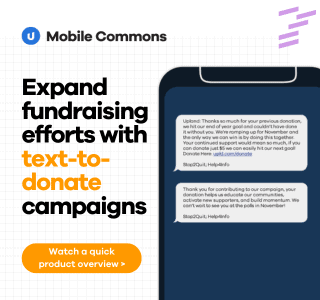Researchers have been publishing studies for years on the effectiveness of text messaging on improving healthcare outcomes. Now, a new survey by Johns Hopkins Medicine adds to this growing library of data. The survey explores cell phone usage in low-income, urban communities, and found that cell phone interventions have strong potential as an effective means of achieving positive healthcare outcomes for inner city, at risk women.
The challenge: Can mobile interventions overcome the challenges of reaching young urban mothers in low-income areas?
 Johns Hopkins researchers focused their efforts on low-income, inner city pregnant and postpartum women. This demographic is especially at risk of diseases – such as diabetes – during their childbearing years, but they are also, unfortunately, a historically difficult population to reach. Language barriers and a lack of educational resources are major obstacles in reaching these women. The resulting communication gap is one of the major contributing factors in poor health for this population as a whole.
Johns Hopkins researchers focused their efforts on low-income, inner city pregnant and postpartum women. This demographic is especially at risk of diseases – such as diabetes – during their childbearing years, but they are also, unfortunately, a historically difficult population to reach. Language barriers and a lack of educational resources are major obstacles in reaching these women. The resulting communication gap is one of the major contributing factors in poor health for this population as a whole.
In order to help improve the health of young urban mothers, the survey wanted to investigate how they communicated, what methods they preferred, and to find out if cell phones can be an effective measure in helping them access resources to help with their pregnancy. As the study’s senior author Wendy Bennett, M.D., M.P.H., explains, “Pregnancy and the year after delivery — when women must see a doctor — give us a window of opportunity to lock in lifelong preventive health behaviors for them and their families. But these opportunities are often missed because many women do not return for care or stay engaged with providers. If we could better understand their use of information and communication technology, we could likely design more appropriate, culturally sensitive ways to reach and help them.”
The survey: Mobile interventions hold high potential of improving the health of at-risk mothers
 The survey focused on a diverse group of 250 low-income, inner city, pregnant and postpartum women located in the Baltimore area. All the participants had utilized the women’s health services at one of four branches of Johns Hopkins hospitals. Diversity was a key part of the study: the group’s make up was 40% African-American, 28% Latina, 23% White, and less than 10% of other racial or ethnic groups.
The survey focused on a diverse group of 250 low-income, inner city, pregnant and postpartum women located in the Baltimore area. All the participants had utilized the women’s health services at one of four branches of Johns Hopkins hospitals. Diversity was a key part of the study: the group’s make up was 40% African-American, 28% Latina, 23% White, and less than 10% of other racial or ethnic groups.
Researchers asked participants to answer a series of questions on their mobile phone habits and preferences. The researchers found that cell phone usage among their target population was extremely prevalent.
- 90% of the women use smartphones or regular cellphones to give and get information.
- The number of women who use text messaging was uniformly high – 85% or higher, in all groups except for African Americans, where it dipped slightly.
According to a report on the survey, published online in the Journal of Internet Medicine Research, the findings “strongly confirm the potential of the devices as a desirable means of improving the health of those at risk for diabetes and other diseases during their childbearing years.”
How text messaging complements patient access to healthcare
 Text messaging is a powerful tool in the healthcare arena for several reasons. Because cell phone ownership is highly prevalent, text messaging becomes a built-in resource for healthcare professionals to communicate with otherwise hard-to-reach populations. And since it’s a familiar, widely used channel, patients are highly likely to engage with it: 90% of all text messages are read within the first 90 seconds of receiving them. Other research confirms that cell phone usage is especially prevalent among minority and underserved populations. Example statistics include the following:
Text messaging is a powerful tool in the healthcare arena for several reasons. Because cell phone ownership is highly prevalent, text messaging becomes a built-in resource for healthcare professionals to communicate with otherwise hard-to-reach populations. And since it’s a familiar, widely used channel, patients are highly likely to engage with it: 90% of all text messages are read within the first 90 seconds of receiving them. Other research confirms that cell phone usage is especially prevalent among minority and underserved populations. Example statistics include the following:
- Hispanics text 1.56 times more than Caucasians.
- African Americans text 2.24 times more than Caucasians.
- Households that make less than $30,000 annually send twice as many text messages as those that make over $75,000.
Nymisha Chilukuri, the Johns Hopkins survey’s first author, believes that the survey’s results can apply to other diverse populations. “Our study highlights the potential for Internet and communication technology where individuals may have multiple ways of reaching out for health information, rather than through a primary care provider alone,” she said.
By reaching patients via text messaging, healthcare professionals can keep them engaged with their health outside of the doctor’s office, while also providing alternate ways to access important resources. The continuous conversation enabled by text messaging provides a more comprehensive care regime than that of traditional doctor visits. This, in turn, enables long-term behavior changes and positive outcomes.
Overall, the Johns Hopkins survey succeeds in providing yet more evidence of support of text messaging as a tool for healthcare providers to reach low-income populations. This is not surprising, however: various other studies have shown that engaging patients through text messaging can achieve specific outcomes, such as reducing the risk of chronic diseases (like diabetes) or encouraging healthy behaviors (like quitting smoking). If you’d like to learn more, here are more resources that help illuminate text messaging’s efficacy in the healthcare sphere:
- Environmental Scan of Text Messaging Interventions Supports SMS Applications in Healthcare
- Use Text Messaging to Achieve Healthcare Behavior Change Outcomes
Interested in continuing the conversation? Please contact us.

